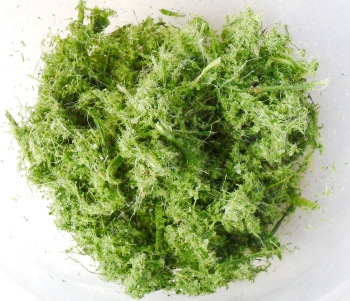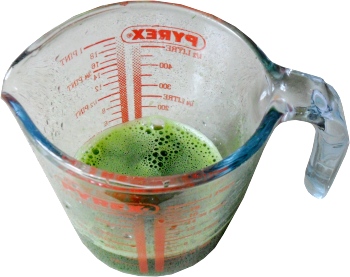Make sure your pandan leaves are fresh-looking - discard/cut out any bad looking bits.
Chop them up into pieces around 5cm/2" long and put them in a hand blender jug - you could use any jug here but the hand blender jug fits the blender nicely and makes the job easier.
Add the water and then put the blender on the low setting and gradually pulp the leaves.
This can take some time.
As an alternative to using a blender, you could use a mortar and pestle but in order to grind this stuff - they are fairly tough leaves - you are going to need a pestle with a rough inside instead of the one shown in the photograph.
 |
this is the pulp after
the blending process. |
Once you have finished pulping it, put it into a sieve and let it drain into a jug.
You can use a little extra water to extract anything that hasn't drained from the pulp on its own.
However, be aware that you don't want to add too much to the volume - for a cake where you would need 200 mls, anything that dilutes it over 200 mls in total will just make waste.
You can, of course, freeze any surplus.
 |
Finally, our
precious 'paste'. |
This is the final product that we have been after - a suspension of fine particulates and oils and solution of various other compounds that makes it worth while.
Just in case you think it is a bit runny for it to be called a 'paste', yes it is, but it is supposed to be like that. Its viscosity is supposed to be similar to water so don't expect anything like peanut butter and then think you have made it incorrectly because it is like this.
It is a lot of effort to make this stuff but it does add something that you don't get from the other products such as pandan essence and kewra water.
However, you might feel that having now made it yourself, you don't need to again (a bit like making your own soya milk - it is easier to buy it in the shops).